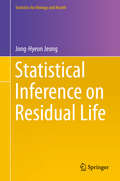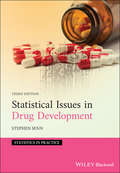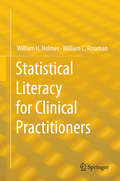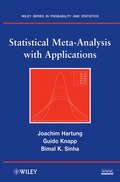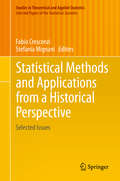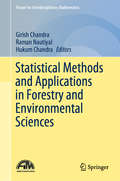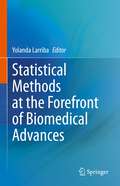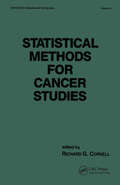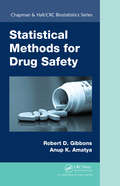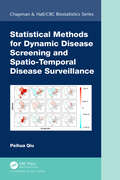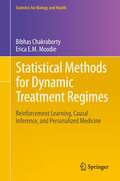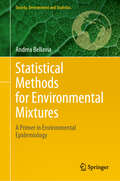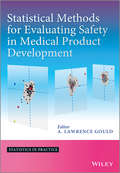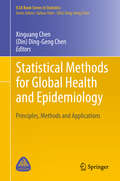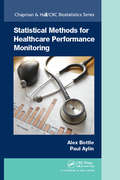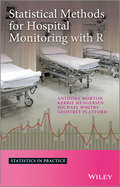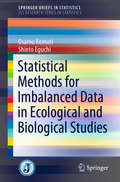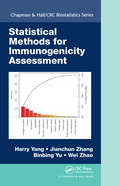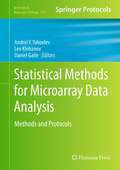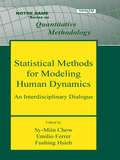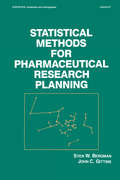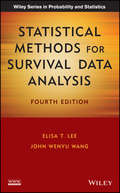- Table View
- List View
Statistical Inference on Residual Life
by Jong-Hyeon JeongThis is a monograph on the concept of residual life, which is an alternative summary measure of time-to-event data, or survival data. The mean residual life has been used for many years under the name of life expectancy, so it is a natural concept for summarizing survival or reliability data. It is also more interpretable than the popular hazard function, especially for communications between patients and physicians regarding the efficacy of a new drug in the medical field. This book reviews existing statistical methods to infer the residual life distribution. The review and comparison includes existing inference methods for mean and median, or quantile, residual life analysis through medical data examples. The concept of the residual life is also extended to competing risks analysis. The targeted audience includes biostatisticians, graduate students, and PhD (bio)statisticians. Knowledge in survival analysis at an introductory graduate level is advisable prior to reading this book.
Statistical Issues in Drug Development (Statistics in Practice)
by Stephen S. SennStatistical Issues in Drug Development The revised third edition of Statistical Issues in Drug Development delivers an insightful treatment of the intersection between statistics and the life sciences. The book offers readers new discussions of crucial topics, including cluster randomization, historical controls, responder analysis, studies in children, post-hoc tests, estimands, publication bias, the replication crisis, and many more.This work presents the major statistical issues in drug development in a way that is accessible and comprehensible to life scientists working in the field, and takes pains not to gloss over significant disagreements in the field of statistics, while encouraging communication between the statistical and life sciences disciplines. In addition to new material on topics like invalid inversion, severity, random effects in network meta-analysis, and explained variation, readers will benefit from the inclusion of:A thorough introduction to basic topics in drug development and statistics, including the role played by statistics in drug developmentAn exploration of the four views of statistics in drug development, including the historical, methodological, technical, and professionalAn examination of debatable and controversial topics in drug development, including the allocation of treatments to patients in clinical trials, baselines and covariate information, and the measurement of treatment effectsPerfect for life scientists and other professionals working in the field of drug development, Statistical Issues in Drug Development is the ideal resource for anyone seeking a one-stop reference to enhance their understanding of the use of statistics during drug development.
Statistical Learning for Biomedical Data
by James D. Malley Karen G. Malley Sinisa PajevicThis book is for anyone who has biomedical data and needs to identify variables that predict an outcome, for two-group outcomes such as tumor/not-tumor, survival/death, or response from treatment. Statistical learning machines are ideally suited to these types of prediction problems, especially if the variables being studied may not meet the assumptions of traditional techniques. Learning machines come from the world of probability and computer science but are not yet widely used in biomedical research. This introduction brings learning machine techniques to the biomedical world in an accessible way, explaining the underlying principles in nontechnical language and using extensive examples and figures. The authors connect these new methods to familiar techniques by showing how to use the learning machine models to generate smaller, more easily interpretable traditional models. Coverage includes single decision trees, multiple-tree techniques such as Random Forests(TM), neural nets, support vector machines, nearest neighbors and boosting.
Statistical Learning from a Regression Perspective (Springer Texts in Statistics)
by Richard A. BerkThis textbook considers statistical learning applications when interest centers on the conditional distribution of a response variable, given a set of predictors, and in the absence of a credible model that can be specified before the data analysis begins. Consistent with modern data analytics, it emphasizes that a proper statistical learning data analysis depends in an integrated fashion on sound data collection, intelligent data management, appropriate statistical procedures, and an accessible interpretation of results. The unifying theme is that supervised learning properly can be seen as a form of regression analysis. Key concepts and procedures are illustrated with a large number of real applications and their associated code in R, with an eye toward practical implications. The growing integration of computer science and statistics is well represented including the occasional, but salient, tensions that result. Throughout, there are links to the big picture. The third edition considers significant advances in recent years, among which are: the development of overarching, conceptual frameworks for statistical learning;the impact of “big data” on statistical learning;the nature and consequences of post-model selection statistical inference;deep learning in various forms;the special challenges to statistical inference posed by statistical learning;the fundamental connections between data collection and data analysis;interdisciplinary ethical and political issues surrounding the application of algorithmic methods in a wide variety of fields, each linked to concerns about transparency, fairness, and accuracy. This edition features new sections on accuracy, transparency, and fairness, as well as a new chapter on deep learning. Precursors to deep learning get an expanded treatment. The connections between fitting and forecasting are considered in greater depth. Discussion of the estimation targets for algorithmic methods is revised and expanded throughout to reflect the latest research. Resampling procedures are emphasized. The material is written for upper undergraduate and graduate students in the social, psychological and life sciences and for researchers who want to apply statistical learning procedures to scientific and policy problems.
Statistical Literacy for Clinical Practitioners
by William H. Holmes William C. RinamanThis textbook on statistics is written for students in medicine, epidemiology, and public health. It builds on the important role evidence-based medicine now plays in the clinical practice of physicians, physician assistants and allied health practitioners. By bringing research design and statistics to the fore, this book can integrate these skills into the curricula of professional programs. Students, particularly practitioners-in-training, will learn statistical skills that are required of today's clinicians. Practice problems at the end of each chapter and downloadable data sets provided by the authors ensure readers get practical experience that they can then apply to their own work.
Statistical Meta-Analysis with Applications
by Bimal K. Sinha Guido Knapp Joachim HartungAn accessible introduction to performing meta-analysis across various areas of researchThe practice of meta-analysis allows researchers to obtain findings from various studies and compile them to verify and form one overall conclusion. Statistical Meta-Analysis with Applications presents the necessary statistical methodologies that allow readers to tackle the four main stages of meta-analysis: problem formulation, data collection, data evaluation, and data analysis and interpretation. Combining the authors' expertise on the topic with a wealth of up-to-date information, this book successfully introduces the essential statistical practices for making thorough and accurate discoveries across a wide array of diverse fields, such as business, public health, biostatistics, and environmental studies.Two main types of statistical analysis serve as the foundation of the methods and techniques: combining tests of effect size and combining estimates of effect size. Additional topics covered include:Meta-analysis regression proceduresMultiple-endpoint and multiple-treatment studiesThe Bayesian approach to meta-analysisPublication biasVote counting proceduresMethods for combining individual tests and combining individual estimatesUsing meta-analysis to analyze binary and ordinal categorical dataNumerous worked-out examples in each chapter provide the reader with a step-by-step understanding of the presented methods. All exercises can be computed using the R and SAS software packages, which are both available via the book's related Web site. Extensive references are also included, outlining additional sources for further study.Requiring only a working knowledge of statistics, Statistical Meta-Analysis with Applications is a valuable supplement for courses in biostatistics, business, public health, and social research at the upper-undergraduate and graduate levels. It is also an excellent reference for applied statisticians working in industry, academia, and government.
Statistical Methodologies with Medical Applications
by Poduri Srs RaoThis book presents the methodology and applications of a range of important topics in statistics, and is designed for graduate students in Statistics and Biostatistics and for medical researchers. Illustrations and more than ninety exercises with solutions are presented. They are constructed from the research findings of the medical journals, summary reports of the Centre for Disease Control (CDC) and the World Health Organization (WHO), and practical situations. The illustrations and exercises are related to topics such as immunization, obesity, hypertension, lipid levels, diet and exercise, harmful effects of smoking and air pollution, and the benefits of gluten free diet. This book can be recommended for a one or two semester graduate level course for students studying Statistics, Biostatistics, Epidemiology and Health Sciences. It will also be useful as a companion for medical researchers and research oriented physicians.
Statistical Methods and Applications from a Historical Perspective
by Fabio Crescenzi Stefania MignaniThe book showcases a selection of peer-reviewed papers, the preliminary versions of which were presented at a conference held 11-13 June 2011 in Bologna and organized jointly by the Italian Statistical Society (SIS), the Institute national Institute of Statistics (ISTAT) and the Bank of Italy. The theme of the conference was "Statistics in the 150 years of the Unification of Italy. " The celebration of the anniversary of Italian unification provided the opportunity to examine and discuss the methodological aspects and applications from a historical perspective and both from a national and international point of view. The critical discussion on the issues of the past has made it possible to focus on recent advances, considering the studies of socio-economic and demographic changes in European countries.
Statistical Methods and Applications in Forestry and Environmental Sciences (Forum for Interdisciplinary Mathematics)
by Girish Chandra Raman Nautiyal Hukum ChandraThis book presents recent developments in statistical methodologies with particular relevance to applications in forestry and environmental sciences. It discusses important methodologies like ranked set sampling, adaptive cluster sampling, small area estimation, calibration approach-based estimators, design of experiments, multivariate techniques, Internet of Things, and ridge regression methods. It also covers the history of the implementation of statistical techniques in Indian forestry and the National Forest Inventory of India.The book is a valuable resource for applied statisticians, students, researchers, and practitioners in the forestry and environment sector. It includes real-world examples and case studies to help readers apply the techniques discussed. It also motivates academicians and researchers to use new technologies in the areas of forestry and environmental sciences with the help of software like R, MATLAB, Statistica, and Mathematica.
Statistical Methods at the Forefront of Biomedical Advances
by Yolanda LarribaThis book presents novel statistics methods and reproducible software that helps to solve challenging problems in biomedicine. Specifically, it consists of a collection of 11 chapters contributed by some of the leading experts in the mathematical and statistical field which address new challenges in very disparate biomedical areas, such as genomics, cancer, circadian biology, microbiome, mental disorders, and more. The mathematical rigor is written in a user-friendly way to serve a general biomedical audience ranging from trainees or students to doctors, as well as scientific researchers, university departments, and PhD students.
Statistical Methods for Cancer Studies
by Richard G. CornellThis book focuses on public health and epidemiologic aspects of cancer, and explores the sources of information concerning the frequency of occurrence of human cancer. It describes statistical methods useful in studying problems arising in the field of cancer and its concurrent development.
Statistical Methods for Drug Safety (Chapman & Hall/CRC Biostatistics Series)
by Robert D. Gibbons Anup AmatyaExplore Important Tools for High-Quality Work in Pharmaceutical SafetyStatistical Methods for Drug Safety presents a wide variety of statistical approaches for analyzing pharmacoepidemiologic data. It covers both commonly used techniques, such as proportional reporting ratios for the analysis of spontaneous adverse event reports, and newer approach
Statistical Methods for Dynamic Disease Screening and Spatio-Temporal Disease Surveillance (Chapman & Hall/CRC Biostatistics Series)
by Peihua QiuDisease screening and disease surveillance (DSDS) constitute two critical areas in public health, each presenting distinctive challenges primarily due to their sequential decision-making nature and complex data structures. Statistical Methods for Dynamic Disease Screening and Spatio-Temporal Disease Surveillance explores numerous recent analytic methodologies that enhance traditional techniques. The author, a prominent researcher specializing in innovative sequential decision-making techniques, demonstrates how these novel methods effectively address the challenges of DSDS.After a concise introduction that lays the groundwork for comprehending the challenges inherent in DSDS, the book delves into fundamental statistical concepts and methods relevant to DSDS. This includes exploration of statistical process control (SPC) charts specifically crafted for sequential decision-making purposes. The subsequent chapters systematically outline recent advancements in dynamic screening system (DySS) methods, fine-tuned for effective disease screening. Additionally, the text covers both traditional and contemporary analytic methods for disease surveillance. It further introduces two recently developed R packages designed for implementing DySS methods and spatio-temporal disease surveillance techniques pioneered by the author's research team.Features• Presents Recent Analytic Methods for DSDS: The book introduces analytic methods for DSDS based on SPC charts. These methods effectively utilize all historical data, accommodating the complex data structure inherent in sequential decision-making processes.• Introduces Recent R Packages: Two recent R packages, DySS and SpTe2M, are introduced. The book not only presents these packages but also demonstrates key DSDS methods using them.• Examines Recent Research Results: The text delves into the latest research findings across various domains, including dynamic disease screening, nonparametric spatio-temporal data modeling and monitoring, and spatio-temporal disease surveillance.• Accessible Description of Methods: Major methods are described in a manner accessible to individuals without advanced knowledge in mathematics and statistics. The goal is to facilitate a clear understanding of ideas and easy implementation.• Real-Data Examples: To aid comprehension, the book provides several real-data examples illustrating key concepts and methods.• Hands-on Exercises: Each chapter includes exercises to encourage hands-on practice, allowing readers to engage directly with the presented methods.
Statistical Methods for Dynamic Treatment Regimes: Reinforcement Learning, Causal Inference, and Personalized Medicine
by Bibhas Chakraborty Erica E.M. MoodieStatistical Methods for Dynamic Treatment Regimes shares state of the art of statistical methods developed to address questions of estimation and inference for dynamic treatment regimes, a branch of personalized medicine. This volume demonstrates these methods with their conceptual underpinnings and illustration through analysis of real and simulated data. These methods are immediately applicable to the practice of personalized medicine, which is a medical paradigm that emphasizes the systematic use of individual patient information to optimize patient health care. This is the first single source to provide an overview of methodology and results gathered from journals, proceedings, and technical reports with the goal of orienting researchers to the field. The first chapter establishes context for the statistical reader in the landscape of personalized medicine. Readers need only have familiarity with elementary calculus, linear algebra, and basic large-sample theory to use this text. Throughout the text, authors direct readers to available code or packages in different statistical languages to facilitate implementation. In cases where code does not already exist, the authors provide analytic approaches in sufficient detail that any researcher with knowledge of statistical programming could implement the methods from scratch. This will be an important volume for a wide range of researchers, including statisticians, epidemiologists, medical researchers, and machine learning researchers interested in medical applications. Advanced graduate students in statistics and biostatistics will also find material in Statistical Methods for Dynamic Treatment Regimes to be a critical part of their studies.
Statistical Methods for Environmental Mixtures: A Primer in Environmental Epidemiology (Society, Environment and Statistics)
by Andrea BellaviaThis book provides a comprehensive introduction to statistical approaches for the assessment of complex environmental exposures, such as pollutants and chemical mixtures, within the exposome framework. Environmental mixtures are defined as groups of 3 or more chemical/pollutants, simultaneously present in nature, consumer products, or in the human body. Assessing the health effects of environmental mixtures poses several methodological challenges due to the high levels of correlation that are often present between environmental chemicals, and by the need of incorporating flexible non-additive and non-linear effects that can capture and describe the complex mechanisms by which environmental exposure contribute to diseases. Several statistical approaches are proposed and discussed, including the application of regression-based approaches (e.g. penalized regression such as LASSO and elastic net, or Bayesian variable selection) for environmental exposures, and novel methods (e.g. weighted quantile sum regression, or Bayesian Kernel Machine Regression) that account for specific complexities of environmental exposures. More recent efforts included are the application of machine learning approaches (e.g. gradient boosting) for environmental data. Statistical Methods for Environmental Mixtures describes the statistical challenges that commonly arise when dealing with environmental exposures and provides an introduction to different statistical approaches for such data. Over the last decade, substantial efforts have been made to transition the statistical framework for environmental exposures in epidemiologic studies from a single-chemical/pollutant to a multi-chemicals/pollutants approach. This book provides a comprehensive introduction to this modern multi-chemicals/pollutants framework. Emphasis is given to interpretability, discussing issues with causal interpretation and translation of scientific finding when applying the discussed statistical approaches for complex environmental exposures. The target audience includes researchers in environmental epidemiology and applied statisticians working in the field. As such, while rigorously presenting the statistical methodologies, the book keeps an applied focus, discussing those settings where each method is appropriate for use and for which question it can be applied, providing examples of accurate presentation and interpretation from the literature, including a basic introduction to R packages and tutorials, as well as discussing assumptions and practical challenges when applying these techniques on real data.
Statistical Methods for Evaluating Safety in Medical Product Development
by A. Lawrence GouldThis book gives professionals in clinical research valuable information on the challenging issues of the design, execution, and management of clinical trials, and how to resolve these issues effectively. It also provides understanding and practical guidance on the application of contemporary statistical methods to contemporary issues in safety evaluation during medical product development. Each chapter provides sufficient detail to the reader to undertake the design and analysis of experiments at various stages of product development, including comprehensive references to the relevant literature.Provides a guide to statistical methods and application in medical product developmentAssists readers in undertaking design and analysis of experiments at various stages of product developmentFeatures case studies throughout the book, as well as, SAS and R code
Statistical Methods for Global Health and Epidemiology: Principles, Methods and Applications (ICSA Book Series in Statistics)
by Xinguang Chen Din Ding-Geng ChenThis book examines statistical methods and models used in the fields of global health and epidemiology. It includes methods such as innovative probability sampling, data harmonization and encryption, and advanced descriptive, analytical and monitory methods. Program codes using R are included as well as real data examples. Contemporary global health and epidemiology involves a myriad of medical and health challenges, including inequality of treatment, the HIV/AIDS epidemic and its subsequent control, the flu, cancer, tobacco control, drug use, and environmental pollution. In addition to its vast scales and telescopic perspective; addressing global health concerns often involves examining resource-limited populations with large geographic, socioeconomic diversities. Therefore, advancing global health requires new epidemiological design, new data, and new methods for sampling, data processing, and statistical analysis. This book provides global health researchers with methods that will enable access to and utilization of existing data. Featuring contributions from both epidemiological and biostatistical scholars, this book is a practical resource for researchers, practitioners, and students in solving global health problems in research, education, training, and consultation.
Statistical Methods for Healthcare Performance Monitoring (Chapman & Hall/CRC Biostatistics Series #92)
by Alex Bottle Paul AylinHealthcare is important to everyone, yet large variations in its quality have been well documented both between and within many countries. With demand and expenditure rising, it’s more crucial than ever to know how well the healthcare system and all its components – from staff member to regional network – are performing. This requires data, which inevitably differ in form and quality. It also requires statistical methods, the output of which needs to be presented so that it can be understood by whoever needs it to make decisions. Statistical Methods for Healthcare Performance Monitoring covers measuring quality, types of data, risk adjustment, defining good and bad performance, statistical monitoring, presenting the results to different audiences and evaluating the monitoring system itself. Using examples from around the world, it brings all the issues and perspectives together in a largely non-technical way for clinicians, managers and methodologists. Statistical Methods for Healthcare Performance Monitoring is aimed at statisticians and researchers who need to know how to measure and compare performance, health service regulators, health service managers with responsibilities for monitoring performance, and quality improvement scientists, including those involved in clinical audits.
Statistical Methods for Hospital Monitoring with R (Statistics in Practice)
by Kerrie L. Mengersen Michael Whitby Anthony Morton Geoffrey PlayfordHospitals monitoring is becoming more complex and is increasing both because staff want their data analysed and because of increasing mandated surveillance. This book provides a suite of functions in R, enabling scientists and data analysts working in infection management and quality improvement departments in hospitals, to analyse their often non-independent data which is frequently in the form of trended, over-dispersed and sometimes auto-correlated time series; this is often difficult to analyse using standard office software. This book provides much-needed guidance on data analysis using R for the growing number of scientists in hospital departments who are responsible for producing reports, and who may have limited statistical expertise. This book explores data analysis using R and is aimed at scientists in hospital departments who are responsible for producing reports, and who are involved in improving safety. Professionals working in the healthcare quality and safety community will also find this book of interest Statistical Methods for Hospital Monitoring with R: Provides functions to perform quality improvement and infection management data analysis. Explores the characteristics of complex systems, such as self-organisation and emergent behaviour, along with their implications for such activities as root-cause analysis and the Pareto principle that seek few key causes of adverse events. Provides a summary of key non-statistical aspects of hospital safety and easy to use functions. Provides R scripts in an accompanying web site enabling analyses to be performed by the reader http://www.wiley.com/go/hospital_monitoring Covers issues that will be of increasing importance in the future, such as, generalised additive models, and complex systems, networks and power laws.
Statistical Methods for Imbalanced Data in Ecological and Biological Studies (SpringerBriefs in Statistics)
by Osamu Komori Shinto EguchiThis book presents a fresh, new approach in that it provides a comprehensive recent review of challenging problems caused by imbalanced data in prediction and classification, and also in that it introduces several of the latest statistical methods of dealing with these problems. The book discusses the property of the imbalance of data from two points of view. The first is quantitative imbalance, meaning that the sample size in one population highly outnumbers that in another population. It includes presence-only data as an extreme case, where the presence of a species is confirmed, whereas the information on its absence is uncertain, which is especially common in ecology in predicting habitat distribution. The second is qualitative imbalance, meaning that the data distribution of one population can be well specified whereas that of the other one shows a highly heterogeneous property. A typical case is the existence of outliers commonly observed in gene expression data, and another is heterogeneous characteristics often observed in a case group in case-control studies. The extension of the logistic regression model, maxent, and AdaBoost for imbalanced data is discussed, providing a new framework for improvement of prediction, classification, and performance of variable selection. Weights functions introduced in the methods play an important role in alleviating the imbalance of data. This book also furnishes a new perspective on these problem and shows some applications of the recently developed statistical methods to real data sets.
Statistical Methods for Immunogenicity Assessment (Chapman & Hall/CRC Biostatistics Series)
by Harry Yang Jianchun Zhang Binbing Yu Wei ZhaoDevelop Effective Immunogenicity Risk Mitigation StrategiesImmunogenicity assessment is a prerequisite for the successful development of biopharmaceuticals, including safety and efficacy evaluation. Using advanced statistical methods in the study design and analysis stages is therefore essential to immunogenicity risk assessment and mitigation stra
Statistical Methods for Microarray Data Analysis
by Lev Klebanov Daniel Gaile Andrei Y. YakovlevMicroarrays for simultaneous measurement of redundancy of RNA species are used in fundamental biology as well as in medical research. Statistically,a microarray may be considered as an observation of very high dimensionality equal to the number of expression levels measured on it. In Statistical Methods for Microarray Data Analysis: Methods and Protocols, expert researchers in the field detail many methods and techniques used to study microarrays, guiding the reader from microarray technology to statistical problems of specific multivariate data analysis. Written in the highly successful Methods in Molecular BiologyTM series format, the chapters include the kind of detailed description and implementation advice that is crucial for getting optimal results in the laboratory. Thorough and intuitive, Statistical Methods for Microarray Data Analysis: Methods and Protocols aids scientists in continuing to study microarrays and the most current statistical methods.
Statistical Methods for Modeling Human Dynamics: An Interdisciplinary Dialogue (Notre Dame Series on Quantitative Methodology)
by Emilio Ferrer Sy-Minn Chow Fushing HsiehThis interdisciplinary volume features contributions from researchers in the fields of psychology, neuroscience, statistics, computer science, and physics. State-of-the-art techniques and applications used to analyze data obtained from studies in cognition, emotion, and electrophysiology are reviewed along with techniques for modeling in real time and for examining lifespan cognitive changes, for conceptualizing change using item response, nonparametric and hierarchical models, and control theory-inspired techniques for deriving diagnoses in medical and psychotherapeutic settings. The syntax for running the analyses presented in the book is provided on the Psychology Press site. Most of the programs are written in R while others are for Matlab, SAS, Win-BUGS, and DyFA. Readers will appreciate a review of the latest methodological techniques developed in the last few years. Highlights include an examination of: Statistical and mathematical modeling techniques for the analysis of brain imaging such as EEGs, fMRIs, and other neuroscience data Dynamic modeling techniques for intensive repeated measurement data Panel modeling techniques for fewer time points data State-space modeling techniques for psychological data Techniques used to analyze reaction time data. Each chapter features an introductory overview of the techniques needed to understand the chapter, a summary, and numerous examples. Each self-contained chapter can be read on its own and in any order. Divided into three major sections, the book examines techniques for examining within-person derivations in change patterns, intra-individual change, and inter-individual differences in change and interpersonal dynamics. Intended for advanced students and researchers, this book will appeal to those interested in applying state-of-the-art dynamic modeling techniques to the the study of neurological, developmental, cognitive, and social/personality psychology, as well as neuroscience, computer science, and engineering.
Statistical Methods for Pharmaceutical Research Planning
by S. W. BergmanThis book focuses on statistical methods which impinge more or less directly on the decisions that are made during the course of pharmaceutical and agro-chemical research, considering the four decision-making areas.
Statistical Methods for Survival Data Analysis
by John Wenyu Wang Elisa T. LeePraise for the Third Edition". . . an easy-to read introduction to survival analysis which covers the major concepts and techniques of the subject." --Statistics in Medical ResearchUpdated and expanded to reflect the latest developments, Statistical Methods for Survival Data Analysis, Fourth Edition continues to deliver a comprehensive introduction to the most commonly-used methods for analyzing survival data. Authored by a uniquely well-qualified author team, the Fourth Edition is a critically acclaimed guide to statistical methods with applications in clinical trials, epidemiology, areas of business, and the social sciences. The book features many real-world examples to illustrate applications within these various fields, although special consideration is given to the study of survival data in biomedical sciences.Emphasizing the latest research and providing the most up-to-date information regarding software applications in the field, Statistical Methods for Survival Data Analysis, Fourth Edition also includes:Marginal and random effect models for analyzing correlated censored or uncensored dataMultiple types of two-sample and K-sample comparison analysisUpdated treatment of parametric methods for regression model fitting with a new focus on accelerated failure time modelsExpanded coverage of the Cox proportional hazards modelExercises at the end of each chapter to deepen knowledge of the presented materialStatistical Methods for Survival Data Analysis is an ideal text for upper-undergraduate and graduate-level courses on survival data analysis. The book is also an excellent resource for biomedical investigators, statisticians, and epidemiologists, as well as researchers in every field in which the analysis of survival data plays a role.
